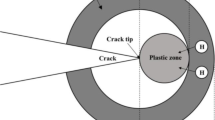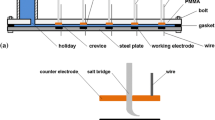Abstract
Crack growth behavior of X65 pipeline steel at free corrosion potential in near-neutral pH soil environment under a CO2 concentration gradient inside a disbonded coating was studied. Growth rates were found to be highest at the open mouth of the simulated disbondment where CO2 concentrations, hence local hydrogen concentration in the local environment, was highest. Careful analysis of growth rate data using a corrosion-fatigue model of the form ΔK α/K βmax /f γ, where (1/f γ) models environmental contribution to growth, revealed that environmental contribution could vary by up to a factor of three. Such intense environmental contribution at the open mouth kept the crack tip atomically sharp despite the simultaneous occurrence of low-temperature creep and crack tip dissolution, which are the factors that blunt the crack tip. At other locations where environmental enhancement was lower, significant crack tip blunting attributed to both low-temperature creep and crack tip dissolution was observed. These factors both led to lower crack growth rates away from the open mouth.















Similar content being viewed by others
References
National Energy Board: Report # MH-2-95, 1996.
Delanty, B., O’beirne, J.: Oil Gas J., 1992 vol. 90(24), pp. 39–44.
J.A. Colwell, B.N. Leis, and P.M. Singh: Paper no. 05161, Corrosion/2005, Houston, TX, 3–7 Apr. 2005.
Parkins, R. N., 2000, “A review of stress corrosion cracking of high pressure gas pipelines,” Corrosion 2000, NACE, Orlando, FL.
R.N. Parkins: PRCI, Report for the Line Pipe Research Supervisory Committee of PRC International, 1999.
Charles, E. A., and Parkins, R. N., Corrosion, 51(7), pp 518-527, 1995.
Brousseau, R., and Qian, S., 1994, Corrosion, vol. 50(12) pp. 907-911.
Yan, M., Wang, J., Han, E., 2008, “Local Environment Under Simulated Disbonded Coating on Steel Pipelines in Soil Solution,” Corrosion Science, 50(5) pp. 1331-1339.
Zhang, G. A., and Cheng, Y. F., 2009, “Micro-Electrochemical Characterization of Corrosion of Welded X70 Pipeline Steel in Near-Neutral pH Solution,” Corrosion Science, 51(8) pp. 1714-1724.
A. Eslami, W. Chen, R.G. Worthingham (2011) Corros. Sci., 53: 2318–2327.
J. Been, R.L. Sutherby: NACE North. Area West. Conf., 2006, Calgary, Canada, Feb 7–8, 2006.
Zhang, X. Y., Lambert, S. B., Sutherby, R. (1999) Corrosion, 55(3) pp. 297-305.
W. Chen and R.L. Sutherby: Metall. Mater. Trans. A, 2007, vol. 38A, pp. 1260–68.
J.A. Beavers and C.E. Jaske: Paper#. 142, Corrosion ‘99, NACE, 1999.
Raykar, N. R., Maiti, S. K., and Raman, R., 2011, “Modelling of Mode-I Stable Crack Growth Under Hydrogen Assisted Stress Corrosion Cracking,” Engineering Fracture Mechanics, 78(18), pp. 3153-3165.
McClung, R. C., and Sehitoglu, H., 1992, ““Closure and Growth of Fatigue Cracks at Notches”,” ASME Journal of Engineering Materials Technology, 114, pp. 1-7.
Haddad, M. H. E., Topper, T. H., and Mukherjee, B., 1981, “Review of New Developments in Crack Propagation Studies,” ASTM Journal of Testing and Evaluation, 9(2) pp. 65-81.
Fine, M.E., and Richie, R.O., 1979, “Fatigue and Microstructure”, American Society for Metals, Metals Park, Ohio, pp. 245.
R.P. Gangloff: Advances in Crack Length Measurement, Engineering Materials Advisory Ltd., Warley, West Midlands, 1983, pp. 175.
S.J. Hudak (1981) J. Eng. Mater. Technol. 103(1): 26–35.
J. Schijve: Fatigue Thresholds, Engineering Materials Advisory Ltd., Warley, West Midlands, 1982, pp. 881.
M.H. El Haddad, K.N. Smith, and T.H. Topper: Fracture Mechanics, ASTM STP 677, 1979, pp. 274–89.
Leis, B. N., and Forte, T. P., 1981, “Fatigue Growth of Initially Physically Short Cracks in Notched Aluminum and Steel Plates,” Fracture Mechanics; Philadelphia; Pa.
B.N. Leis and R.D. Galliher: Fatigue and Life Prediction, ASTM STP 770, American Society for Testing and Materials, 1982, pp. 399–421.
Leis, B. N., 1982, “Fatigue Crack Propagation through Inelastic Gradient Fields,” International Journal of Pressure Vessels and Piping, 10(2) pp. 141-158.
C.S. Shin, R.A. Smith: Eng. Fract. Mech. 29(3): 301-315, 1988.
Sun, S., Shiozawa, K., Gu, J., 1995, “Investigation of Deformation Field and Hydrogen Partition Around Crack Tip in Fcc Single Crystal,” Metall. Mater. Trans. A, 26A(3) pp. 731-739.
Shin, C. S., and Smith, R. A., 1985, “Fatigue Crack Growth from Sharp Notches,” Int. J. Fatigue, 7(2) pp. 87-93.
Tanaka, K., and Nakai, Y., 1983, “Propagation and Non-propagation of Short Fatigue Cracks at a Sharp Notch,” Fatigue Eng. Mater. Struct., 6(4) pp. 315-327.
SEHITOGLU, H., 1983, “Fatigue Life Prediction of Notched Members Based on Local Strain and Elastic–Plastic Fracture Mechanics Concepts,” Eng. Fract. Mech., 18(3) pp. 609-621.
Sehitoglu, H., 1985, “Characterization of Crack Closure,” Fracture Mechanics: Sixteenth Symposium; Columbus, (868) pp. 361-380.
Anderson, T.L., 2005, “Fracture Mechanics - Fundamentals and Applications,” 3rd edition, Taylor & Francis, New York.
SURESH, S., 1991, “Fatigue of Materials”, Cambridge University Press, Cambridge.
SURESH, S., and RITCHIE, R. O., 1984, “Propagation of Short Fatigue Cracks,” Int. Met. Rev., 29(6) pp. 445-476.
H. Kitagawa, S. Takahashi, and S. Suh: ASTM-STP 675, ASTM, 1979, pp. 420–49.
H. Kitagawa and S. Takahashi: Proc. 2nd Int. Conf. on Mech. Beh. of Matls. 1976 pp. 627–31.
El Haddad, M. H., Smith, K. N., and Topper, T. H., 1979, “Fatigue Crack Propagation of Short Cracks,” ASME Journal of Engineering Materials Technology, 101pp. 42.
Zheng, W. Y., 2008, “Stress Corrosion Cracking of Oil and Gas Pipelines in Near Neutral pH Environment: Review of Recent Research,” Energy Materials: Materials Science & Engineering for Energy Systems, 3(4) pp. 220-226.
Boven, G. V., Chen, W., and Rogge, R., 2007, “The Role of Residual Stress in Neutral pH Stress Corrosion Cracking of Pipeline Steels. Part I: Pitting and Cracking Occurrence,” Acta Materialia, 55(1) pp. 29-42.
Eslami, A., Fang, B., Kania, R., 2010, “Stress Corrosion Cracking Initiation Under the Disbonded Coating of Pipeline Steel in Near-Neutral pH Environment,” Corrosion Science, 52(11) pp. 3750-3756.
S. Asher, P. Singh, and J. Colwell: 16th Int. Corros. Congress, Beijing, China, 2005.
Chen, W., Kania, R., Worthingham, R., 2009, “Transgranular Crack Growth in the Pipeline Steels Exposed to Near-Neutral pH Soil Aqueous Solutions: The Role of Hydrogen,” Acta Materialia, 57(20) pp. 6200-6214.
Li, J. C. M., Oriani, R. A., and Darken, L. S., 1966, “Thermodynamics of Stressed Solids,” Z. Physik. Chem., 49, pp. 271-290.
R.P. Gangloff: Comprehensive Structure Integrity, vol. 6: Environmentally-Assisted Fracture, Elsevier, Oxford, 2003.
Thomas, R. L. S., Scully, J. R., and Gangloff, R. P., 2003, “Internal Hydrogen Embrittlement of Ultrahigh-Strength AERMET 100 Steel,” Metallurgical and Materials Transactions A, 34A(2), pp. 327-344A.
K. Chevil, A. Eslami, and W. Chen: Paper no. 90675, Int. Pipeline Conf. 2012.
Acknowledgment
This work was financially supported by NSERC, TransCanada Pipelines limited, Spectra Energy, and US Department of Transportation. The authors gratefully acknowledge their financial support.
Author information
Authors and Affiliations
Corresponding author
Additional information
Manuscript submitted July 12, 2013.
Appendix
Appendix
Conversion of the potential drop readings to actual crack sizes was done using a self-developed curve fitting method since none of the methods listed in the literature was found to work due to the unique geometry of the cracks. The method used is summarized below.
It is known that the potential drop is related to the crack area through the resistivity of the material:
where R is the resistance of material, A * is the area of the un-cracked ligament, and l is the length between the signal wires. The voltage across the crack crevice, V, can be related to the applied current, I, which was kept constant, and the resistance of the material in the un-cracked ligament through the following relation:
For the specimen used in the current investigation, it is obvious that
where A is the cross-sectional area of gage area, and A c is the instantaneous crack area. Therefore,
The initial and final crack sizes are known measurable values. Therefore, the measured potential drop could be related to the point to point crack area. Since ρ is a finite value at every point on the curve, the numerator in Eq. [4] could be treated as a constant so that
To convert the full potential drop data to actual cracks sizes, the following steps could be used:
-
1.
On the original potential vs time plot, select a few points (up to 12 was used).
-
2.
Record the potentials and times at these points. Convert the times to number of stress cycles (N) that elapsed up to that point during the test.
-
3.
Make a plot of the inverse of the initial and final remaining crack ligaments to the corresponding potential drop values to obtain a linear relationship between V and A *.
-
4.
Use the relationship obtained in step 3 to determine an approximate value for A * for each of the points selected in step 2.
-
5.
From each value of A *, determine the value of A c, the crack area.
-
6.
A c could then be related to the area of a semi-ellipse:
where a is the crack depth and c is the crack size measure along the major semi-axis at the sample surface.
-
7.
Plot the initial and final values of ‘c’ against the initial and final values of ‘a’ to obtain a linear relationship between ‘c’ and ‘a’.
-
8.
The relationship obtained could then be used to substitute for c in Eq. [6].
-
9.
The resulting equation could then be solved for ‘a’ to obtain the crack depth at all the points selected in step 1.
-
10.
Finally, the values of ‘c’ could then be obtained using the relationship obtained in step 7.
The crack growth data obtained by the potential drop method were used to obtain crack growth rates per cycle da/dN, where the da/dN is the slope of the crack size vs number of cycle plot. Also, corrosion-fatigue analysis was carried out using Chen’s corrosion-fatigue model to calculate the so-called combined factor \( (\varDelta K)^{2} K_{\hbox{max} } /f^{\gamma } \). All data were finally presented as a da/dN vs combined factor plot. K max was calculated using stress-intensity solution for a semielliptical surface flaw in a flat plate for a ≤ c (see Table A9.1, p. 434, in Reference 32). A value of 0.1 was assigned to γ as deduced by Chen and Sutherby[13].
Rights and permissions
About this article
Cite this article
Egbewande, A., Chen, W., Eadie, R. et al. Surface Crack Growth Behavior of Pipeline Steel Under Disbonded Coating at Free Corrosion Potential in Near-Neutral pH Soil Environments. Metall Mater Trans A 45, 4946–4959 (2014). https://doi.org/10.1007/s11661-014-2458-z
Published:
Issue Date:
DOI: https://doi.org/10.1007/s11661-014-2458-z




